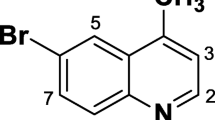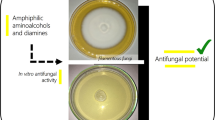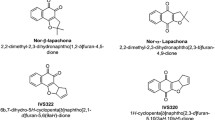Abstract
Infections caused by dermatophytes, mainly Trichophyton rubrum,are often vulnerable to relapses upon cessation of antifungal therapy, reinforcing the need of new antifungals. Aldimines have potential biological activities, but there are few reports on their antifungal profile. The aim of this study was to evaluate the antifungal activity of 2-(benzylideneamino)phenol (3A3) and 4-(benzylideneamino)phenol (3A4) against dermatophytes. We determined the minimum inhibitory concentration, minimum fungicidal concentration, time-kill curves and fractional inhibitory concentration of the combination of 3A3, 3A4 and itraconazole against a set of isolates of T. rubrum and T. interdigitale. 3A3 was tested in a murine model of dermatophytoses caused by T. rubrum, and the effect on phagocytosis was assessed. The MIC values ranged from 8 to 32 μg/mL for 3A3 and from 64 to 256 μg/mL for 3A4. The interaction between 3A3 and 3A4 with itraconazole proved to be synergistic and indifferent, respectively. 3A3 was as efficient as itraconazole in reducing the fungal burden on the skin of mice, being this effect associated with the influx of neutrophil and macrophage. Also, 3A3 was able to increase the internalization of conidia by macrophages. Altogether, our data encourage future clinical studies with 3A3 to treat dermatophytoses.





Similar content being viewed by others
References
Gupta AK, Tu LQ. Dermatophytes: diagnosis and treatment. J Am Acad Dermatol. 2006;54:1050–5.
Weitzman I, Summerbell RC. The dermatophytes. Clin Microbiol Rev. 1995;8:240–59.
Gupta AK, Cooper EA. Update in antifungal therapy of dermatophytosis. Mycopathologia. 2008;166:353–67.
Santos DA, Araújo RAC, Kholer LM, et al. Molecular typing and antifungal susceptibility of Trichophyton rubrum isolates from patients with onychomycosis pre and post treatment. Int J Antimicrob Agents. 2007;29:563–9.
Gräser Y, Scott J, Summerbell R. The new species concept in dermatophytes: a polyphasic approach. Mycopathologia. 2008;166:239–56.
Shaw JW, Joish VN, Coons SJ. Onychomycosis: health-related quality of life considerations. Pharmacoeconomics. 2002;20:23–6.
Degreef H. Clinical forms of dermatophytosis (ringworm infection). Mycopathologia. 2008;166:257–65.
Woodfolk JA, Platts-Mills TA. Diversity of the human allergen-specific T cell repertoire associated with distinct skin test reactions: delayed-type hypersensitivity-associated major epitopes induce Th1- and Th2-dominated responses. J Immunol. 2001;167(Suppl 9):5412–9.
Almeida SR. Immunology of dermatophytosis. Mycopathologia. 2008;166:277–83.
Baltazar LDM, Soares BM, Carneiro HCS, et al. Photodynamic inhibition of Trichophyton rubrum: in vitro activity and the role of oxidative and nitrosative bursts in fungal death. J Antimicrob Chemother. 2013;68:354–61.
Martinez-Rossi NM, Peres NTA, Rossi A. Antifungal resistance mechanisms in dermatophytes. Mycopathologia. 2008;5(Suppl 6):369–83.
Odds FC, Brown AJP, Gow NAR. Antifungal agents: mechanisms of acion. Trends Microbiol. 2003;11(Suppl 6):272–9.
Fernández-Torres B, Inza I, Guarro J. In vitro activities of the new antifungal drug erbeconazole and three other topical agents against 200 strains of dermatophytes. J Clin Microbiol. 2003;41:5209–11.
Fohrer C, Fornecker L, et al. Antifungal combination treatment: a future perspective. Int J Antimicrob Agents. 2006;27:25–30.
Da Silva CM, da Silva DL, Modolo LV, et al. Schiff bases: a short review of their antimicrobial activities. J Adv Res. 2011;2:1–8.
Kulkarni A, Patil SA, Badami PS. Synthesis, characterization, DNA cleavage and in vitro antimicrobial studies of La(III), Th(IV) and VO(IV) complexes with Schiff bases of coumarin derivatives. Eur J Med Chem. 2009;44(Suppl 7):2904–12.
Da Silva CM, da Silva DL, Martins CVB, et al. Synthesis of aryl aldimines and their activity against fungi of clinical interest. Chem Biol Drug Des. 2011;78:810–5.
Santos DA, Hamdan JS. Evaluation of broth microdilution antifungal susceptibility testing conditions for Trichophyton rubrum. J Clin Microbiol. 2005;43:1917–20.
Santos DA, Barros MES, Hamdan JS. Establishing a method of inoculum preparation for susceptibility testing of Trichophyton rubrum and Trichophyton mentagrophytes. J Clin Microbiol. 2006;44:98–101.
Clinical and Laboratory Standards Institute. Reference method for broth dilution antifungal susceptibility testing of filamentous fungi: aproved standard M38-A2. Wayne: CLSI; 2008.
Espinel-Ingroff A. Comparison of in vitro activities pf the new triazole SCH56592 and the echinocandins MK-0991 (L-743,872) and LY303366 against opportunistic filamentous and dimorphic fungi and yeasts. J Clin Microbiol. 1998;36:2950–6.
Santos JRA, Gouveia LF, Taylor ELS, et al. Dynamic interaction between fluconazole and amphotericin B against Cryptococcus gattii. Antimicrob Agents Chemother. 2012;56:2553–8.
Fernández Freire P, Labrador V, Pérez Martín JM, Hazen MJ. Cytotoxic effects in mammalian Vero cells exposed to pentachlorophenol. Toxicology. 2005;210(Suppl 1):37–44.
Martins CVB, de Resende MA, Magalhães TFF, et al. Antifungal activity of goniothalamin enantiomers. Lett Drug Des Discov. 2008;5:74–8.
Agência Nacional de Vigilância Sanitária (National Agency for Sanitary Vigilance). Brazilian pharmacopoeia national formulary: second edition. Brazil: ANVISA; 2012.
Baltazar LM, Santos PC, Paula TP, et al. IFN-γ impairs Trichophyton rubrum proliferation in a murine model of dermatophytosis through the production of IL-1β and reactive oxygen species. Med Mycol. 2013;52:1–10.
Lacaz CS, Porto E, Martins JEC. Tratado de micologia médica. São Paulo: Sarvier; 2002.
Matos IM, Souza DG, Seabra DG, et al. Effects of tachykinin NK1 or PAF receptor blockade on the lung injury induced by scorpion venom in rats. Eur J Pharmacol. 1999;376:293–300.
Souza DG, Soares AC, Pinho V, et al. Increased mortality and inflammation in tumor necrosis factor-stimulated gene-14 transgenic mice after ischemia and reperfusion injury. Am J Pathol. 2002;160:1755–65.
Barcelos LS, Talvani A, Teixeira AS, et al. Impaired inflammatory angiogenesis, but not leukocyte influx, in mice lacking TNFR1. J Leukoc Biol. 2005;78:352–8.
Campos MRM, Russo M, Gomes E, Almeida SR. Stimulation, inhibition and death of macrophages infected with Trichophyton rubrum. Microbes Infect. 2006;8:372–9.
Oda LM, Kubelka CF, Alviano CS, Travassos LR. Ingestion of yeast forms of Sporothrix schenckii by mouse peritoneal macrophages. Infect Immun. 1983;39:497–504.
Olafsson JH, Sigurgeirsson B, Baran R. Combination therapy for onychomycosis. Br J Dermatol. 2003;14(Suppl 65):15–8.
Klepser ME, Ernst EJ, Lewis RE, et al. Influence of test conditions on antifungal time-kill curve results: proposal for standardized methods. Antimicrob Agents Chemother. 1998;42(Suppl 5):1207–12.
Acknowledgments
The authors thank to Pharlab (Brazil) for the donation of itraconazole standard powder. This work was supported by Fundação de Amparo à Pesquisa do Estado de Minas Gerais (FAPEMIG Grant CBB-APQ-00874-11); Coordenação de Aperfeiçoamento de Pessoal de Nível Superior (CAPES); Universidade Federal de Minas Gerais (Programa de Auxílio à Pesquisa de Doutores Recém-Contratados); and Conselho Nacional de Desenvolvimento Científico e Tecnológico (CNPq Grant 471894/2011-7).
Conflict of interest
The authors reported no conflict of interest.
Author information
Authors and Affiliations
Corresponding author
Rights and permissions
About this article
Cite this article
Gasparto, A.K., Baltazar, L.M., Gouveia, L.F. et al. 2-(Benzylideneamino)phenol: A Promising Hydroxyaldimine with Potent Activity Against Dermatophytoses. Mycopathologia 179, 243–251 (2015). https://doi.org/10.1007/s11046-014-9850-5
Received:
Accepted:
Published:
Issue Date:
DOI: https://doi.org/10.1007/s11046-014-9850-5




